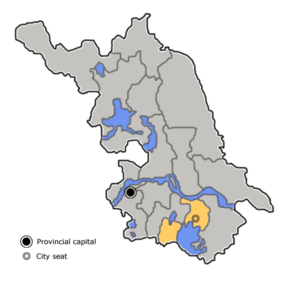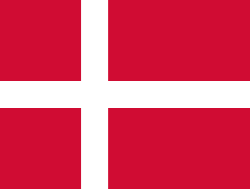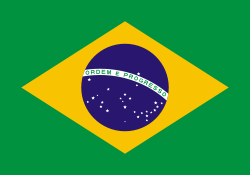Wuxi
 |
|
| Administration Type | Prefecture-level city |
| City Seat | Chong'an District () |
| Area - Total - Urban center |
4,787.61 km² 1,659 km² |
| Population - Total - Urban center |
4,471,900 (2004) 2,235,700 (2004) |
| GDP - Total - Per Capita |
¥385.8 billion (2007) ¥65,203 (2007) |
| Major Nationalities | Han |
| County-level divisions | 8 |
| Township-level divisions | 73 |
| CPC Committee Secretary | Yang Weize (杨卫泽) |
| Mayor | Mao Xiaoping (毛小平) |
| Area code | 510 |
| Postal Code | 214000 (Urban center) 214200, 214400 (Other areas) |
| License Plate Prefix | 苏B |
Wuxi (simplified Chinese: 无锡; traditional Chinese: 無錫; pinyin: Wúxī; former spellings: Wu-shi, Wushi, or Wusih; lit. "Without Tin") is an old city in Jiangsu province, People's Republic of China. Split into halves by Lake Taihu, Wuxi borders Changzhou to the west and Suzhou to the east. The northern half looks across to Taizhou to the north over the Yangtze River, while the southern half also borders the province of Zhejiang to the south. Because of its recent development, Wuxi has been dubbed the "little Shanghai".
Contents |
Administration
The prefecture-level city of Wuxi administers 9 county-level divisions, including 7 districts and 2 county-level cities.
- Chong'an District (崇安区)
- Nanchang District (南长区)
- Beitang District (北塘区)
- Binhu District (滨湖区)
- Huishan District (惠山区)
- Xishan District (锡山区)
- Wuxi New District (无锡新区)
- Jiangyin City (江阴市)
- Yixing City (宜兴市)
These are further divided into 73 township-level divisions, including 59 towns and 24 subdistricts.
Geography
The city plan, as is typical of many older Chinese cities, is of a central city with a roughly circular plan, crisscrossed with older canals, the main canal still seeing heavy barge traffic.
Wuxi itself is on an alluvial plain of deep sedimentary deposits cut between limestone foothills, making it one of the sources for "scholar's rocks", the intricately weathered stones which were used as devices for contemplation.
Wuxi ranges from a very hot summer to a chilly winter, having an average annual temperature of 18 °C, though it seldom sees snow. Because of its proximity to the East China Sea, it has a monsoon season and receives 100 cm of rain annually.
History
Zhou Dynasty
Wuxi was founded 3,000 years ago by two fugitive princes, Taibo and Zhongyong, of Zhou from northern China, who intended to give their brother "Jili" the throne. The two princes settled down in "meili", which is believed to be today's Meicun of Wuxi (albeit some historic records lead to somewhere in today's Suzhou). They helped developing local agriculture and waterways and soon this area flourished. After the death of Taibo, because Taibo has no son, the emperor of Zhou named a descendant of his family king of kingdom "Wu". The king called his kingdom itself "Gowu". Taibo's shrine was set up in today's Meicun and the original wood structure was destroyed during the wars over the history. It has been renovated several times and today's architecture is mostly from Qing dynasty. A stone carved with Confucius' comment can still be seen in today's Taibo Shine.
Spring and Autumn Period and Warring States Period
Wu became one of the strongest kingdoms during the spring and autumn period. Sunzi (Suntzu), who wrote the famous "the Art of War" came to Wu and helped the king in military. Wu was considered one of the five strongest kingdoms during Spring and Autumn Period (春秋五霸). Some of Sunzi's descendants are still living in Sunxiang in Wuxi near the Plum Garden. However, Wu was defeated by Yue (today's Zhejiang and Fujian) later on, which was also defeated by Chu later and Wu became part of Chu during the Warring States Period.
Qin and Han Dynasty
The culture and economy center of "Wu" area shifted to Suzhou after Yinzheng, the first emperor united China and Wuxi belongs to Suzhou back then. During the Han dynasty, Wuxi was set up as a county by the emperor Wudi. Historic records showed that Tin was discovered during the early ages of Han and conflicts arose in this area because of Tin. Soon it ran out of Tin and some people think this is the reason why it was called Wuxi (No tin), but some historians disagree with this opinion and think "Wu" is just the local dialect, which has rich auxiliary words with not much meaning just like Suzhou was called "Gusu" and Wu was called "Gowu" and the name was changed to Youxi (with Tin) during Wang Mang conflicts period just because Wang wanted to change to a different name.
Six dynasties, Tang and Song Dynasties
Agriculture and silk industry flourished in Wuxi especially after the construction of the great canal. Although, Suzhou became a bigger center of Wu area, Wuxi is an important county of Wu.
Yuan, Ming and Qing Dynasties and on
The agriculture (rice and fish as major products) and industry continued to develop and until the early 20th century, Wuxi became a center of the textile industry in China and one of the four most important rice markets nationwide. During the period between 1900 and 1940, Wuxi was considered a most important county in China. That is why in dramatist Caoyu's famous drama "Leiyu" ('Thunder Rain') Wuxi was mentioned several times with a comment "Wuxi is a good place". After the PRC was set up by communist in 1949, Wuxi continued to grow in importance, with the establishment of more textile production and both light and heavy industry. This city was considered a third important city in the Jiangsu province just after the capital city Nanjing and Suzhou, with being given driving sequence "Jiangsu 02" (Nanjing is "Jiangsu 01"). However, its developmental model was criticized among people because of the cost of environmental deterioration. New strategies are demanded by the people to ensure its continuous development with heavy pollution.
Economy
Currently Wuxi is designated an investment grade city, and has two large industrial parks devoted to new industry. While current manufacturing centers on textiles, there is a project to move to electric motor manufacturing and MRP software development.
According to most recent figures (2002) from the local government, 24% of economic activity is textile trade, and another 25% is industrial based manufacturing, including motors, molds and casting, with another 8% being light industry.
The GDP per capita was ¥65,203 (ca. US$8,926) in 2007, ranked no.2 in Jiangsu Province, less than Suzhou but more than the capital city Nanjing.
The center of the city is filled with modern high rise buildings which may destroy the traditional atmosphere for one thousand years and the market is being redeveloped in a postmodern style.
Culture
Wuxi was originally a mining town, which, legend has it, exhausted its tin deposits, hence its name, which in Chinese literally means "tinless". Another opinion about the origin of the city's name is, because one old saying "Mining tin leads to war over China (because in bronze era all weapons need tin); Without tin (tinless) will lead to peace over China" ("有锡兵,天下争;无锡宁,天下清"), the word "tinless" became the name of the city. Whichever is correct, this city's old history is definitely related to the metal tin.
It subsequently became an arts and cultural center, with several famous Chinese authors claiming Wuxi as their home town. Among them, most recently, Qian Zhongshu, author of Fortress Besieged, a comedy of manners set in China in the 1930s.
One of the handicraft specialties of Wuxi is the production of Huishan clay figurines.
In modern times Wuxi has produced a number of cultural figures such as Hua Yanjun (1893-1950) also known as "Blind Abing" (瞎子阿炳), famous for his erhu and pipa music. Another famous musician is Liu Tianhua, who was the first to compile folk music using staff.
As for cuisine, Wuxi is famous for its Wuxi-style spareribs, sweetened pork mini buns and oil gluten.
Transportation
By rail, Wuxi is conveniently situated on the Nanjing-Shanghai Railway, linking it directly with the provincial capital of Nanjing (2 hour train-ride) and China's economic hub, Shanghai (1.5 hours train-ride) and the fifth biggest economic hub and top of china's tourist destinations, Suzhou. K-series trains all stop at Wuxi. Wuxi Airport, which opened in 2004, is situated 14 km from city centre, and has direct flights to Beijing, Guangzhou, Shenzhen, Hong Kong and other Chinese cities.
Folklore
The nine peaks of Huishan, in Xihui Park on the western outskirts of Wuxi, are said to be the sleeping sons of the legendary Dragon King.
The wittiness of Wuxi natives is legendary. A popular joke is that "they can sell you meat that is really bones and they sell you dumplings that are just air inside", i.e. Wuxi pork ribs and Wuxi fried tofu dumplings, which are hollow. Some consider this trait untrustworthy.
Tourism

Wuxi is a tourist spot in the Lower Yangtze Delta. It has both natural and man-made places of interest.
Lake Tai: The city was built on its shore. Naturally the lake is a rich tourism resource. Famous spots include Yuantou Zhu (the Islet of Turtlehead), Taihu Xiandao (Islands of the Deities).
Xi Shan, Huishan: Literally means "Mountain of Tin" and "Mountain of Kindheartedness". They are two small hills located at the western part of the city. The classic royal Ji-chang-yuan Gardens are located at the hill foot area as well as the very famous Tian-xia-di-er-quan Spring (lit. second best spring).NOTE: Please distinguish that Xi Shan is also a name for a more attractive tourist spot located in Suzhou. Because "Xi" has two meanings: one is "west", the other is the name for a metal material tin.
The Grand Canal: It passes the city. There are two canals: one is the old canal that has been there ever since it was excavated, the other is the new canal created after 1949.
Wuxi is famous for the many private gardens or parks built by learned scholars and rich people in the past. Among them, Li Yuan, Mei Yuan are good examples that have been well preserved. Xihui Gongyuan (Xihui Park), located at the foot of Xi Shan also houses historical relics, notably Jichang Garden.
Education
Universities and Colleges
- Jiangnan University (江南大学)
Wuxi Professional College of Science and Technology
High Schools
- Wuxi Furen High School (No.2 Senior High School) (无锡市辅仁中学)
- Wuxi No.1 Senior High School (无锡市第一中学)
- Wuxi Qingshan High School (无锡市青山中学)
- Wuxi No.3 High School (无锡市第三中学)
- Jiangsu Tianyi High School (江苏省天一中学)
- Big Bridge Experimental School (无锡市大桥实验中学)
- Jiangsu Xishan Senior High School (江苏省锡山高级中学)
Notable people
- Gu Kaizhi (latter half of the 4th century), a painter.
- Li Sheng (772-846), poet, who lived and was buried in Wuxi.
- Gu Xiancheng (1550-1612), scholar and politician, especially famous of "Dong Lin Movement".
- Xu Xiake (1587–1641), Ming Dynasty traveller and writer.
- Hua Hengfang (1833-1902), mathematics in late Qing Dynasty who did studies in various area of science and technology. He participated in designing the first streamer and the first steamboat in China.
- Xue Fucheng (1838-1894), well-known ideologists, diplomatists and one of leading exponents to make national bourgeoisie reform in late Qing Dynasty.
- Rong Desheng (1875-1952), the largest national capitalist in the Min Guo era, most famed for his contribution to the Chinese texitle industry.
- Abing (1893-1950) folk musician, best known for his work "Er Quan Ying Yue" (moon reflected on Er stream) for the erhu.
- Xu Beihong (1895–1953), painter, most famed for his paintings of horses.
- Qian Zhongshu (1910–1998), writer, best known for his comedy of manners Fortress Besieged.
- Ding Junhui (1987-), teenage Snooker sensation.
- Zhou Yongkang (1942-), senior Communist Party of China leader
- Yu Liu (1988-), teenage, Wright State Student who failed math and english
Gallery
Sister Cities
 Cascais, Portugal (September 14, 1993)
Cascais, Portugal (September 14, 1993) Akashi, Japan (since August 29, 1981)
Akashi, Japan (since August 29, 1981) Chattanooga, Tennessee U.S. (October 12, 1982)
Chattanooga, Tennessee U.S. (October 12, 1982) Sagamihara, Japan (August 6, 1985)
Sagamihara, Japan (August 6, 1985) Hamilton, New Zealand (July 5, 1986)
Hamilton, New Zealand (July 5, 1986) Scarborough, Ontario Canada (April 10, 1996)
Scarborough, Ontario Canada (April 10, 1996) Davis, California (October, 2003)
Davis, California (October, 2003) Alameda, California USA (2004)
Alameda, California USA (2004) Bocholt, Germany
Bocholt, Germany Gimhae, South Korea (December 14, 2005)
Gimhae, South Korea (December 14, 2005) Daejeon, South Korea (August 27, 2006)
Daejeon, South Korea (August 27, 2006) Ballerup, Egedal and Frederikssund municipalities, Denmark (2007)
Ballerup, Egedal and Frederikssund municipalities, Denmark (2007) Zielona Gora, Poland 2008
Zielona Gora, Poland 2008
The two county-level cities administered by Wuxi, Jiangyin and Yixing, are also twinned with:
 Belo Horizonte, Brazil (November 18, 1996)
Belo Horizonte, Brazil (November 18, 1996) Novo Mesto, Slovenia (May 6, 1994)
Novo Mesto, Slovenia (May 6, 1994)
See also
- Jiangnan
- List of cities in the People's Republic of China by population
External links
- Government website of Wuxi (available in Chinese, Japanese and English)
- Wuxi city guide with open directory (Jiangsu Network)
- English Expat Online Community (available in English)
- Wuxi small guide
- Wuxi bilingual Christian Church
|
||||||||||||||||||
